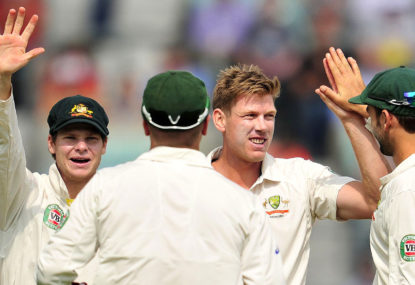It has been suggested by some Australia should rest Ryan Harris for the Adelaide Test to protect him from being over-bowled in what is expected to be a high-scoring affair on a placid pitch.
Australia clearly need to manage the health of their best yet most fragile fast bowler.
Prior to his current run of five consecutive Tests, Harris had never survived more than three matches on the trot without suffering a significant injury.
He escaped with a light workload in the Ashes opener at the Gabba, sending down just 34 overs as England twice folded cheaply.
The Australian selectors are reportedly planning to play Harris next week and correctly so, as it would be folly to omit the one bowler who consistently has tormented England.
Australia have their foot planted on the Poms’ collective throats.
But nothing should be taken for granted at Adelaide.
England are a tremendously resilient team. Their batsmen would be sporting wide, disbelieving grins were Australia to sideline Harris.
The logical desire to protect Harris ahead of the third Test on a WACA surface, which will offer him generous assistance, may see all-rounder James Faulkner replace George Bailey at Adelaide.
The selectors will be wary of England’s ability to keep Australia in the field for a considerable length of time in the batsman-friendly conditions.
Peter Siddle and Ben Hilfenhaus were bowled into the ground against South Africa at Adelaide last summer, after James Pattinson suffered a series-ending injury.
The Proteas batted for 148 overs in the fourth innings to stave off defeat.
The pitch was so lifeless neither the quicks nor the spinners could pose a consistent threat throughout the Test.
Adelaide Oval curator Damian Hough said this week he expected the new drop-in surface to behave in a very similar manner.
There may be something in it for the quicks early in the match but it would then flatten out significantly.
He suggested, just like last summer’s Test deck, it would not break up towards the end of the match and as such would provide scant joy for spinners Nathan Lyon and Graeme Swann.
The high scores racked up at Adelaide by Sheffield Shield teams this season point to a likely run-fest.
Faulkner, then, could greatly reduce the workload of the frontline quicks, keeping them fresher for the WACA, where they may well run amok.
The Aussies were reticent to bowl injury-prone Shane Watson at Brisbane and it seems improbable he will deliver more than a handful of overs in the second Test.
The inclusion of Faulkner would require Brad Haddin to move up to six.
The wicketkeeper’s sublime touch with the blade at the Gabba means this may be less of a risk than usual.
It would, of course, be very harsh on Bailey. The Tasmanian captain scored three and 34 on debut at the Gabba.
However, dropping him in favour of Faulkner would not be an indication the selectors have seen enough to mark his cards.
Rather it would be a pragmatic selection designed to shield Australia’s precious pace attack.
Undoubtedly, it would weaken Australia’s batting, although I would argue Adelaide Oval is perhaps the least risky venue for making such a move given its genial pitch.
Faulkner is combative with the bat and is in solid form.
In both his Shield games this summer he has batted in the top six for Tasmania ahead of Tim Paine.
It has been an interesting elevation in the order, considering Faulkner has typically batted at eight the past few seasons.
It is possible this was done at the request of the Australian selectors, who would have been keen to see Faulkner entrusted with greater responsibility with the blade.
He has responded reasonably well, scoring 147 runs at 37, including two half centuries.
The left armer’s bowling form has not been as compelling.
Faulkner has snared just four wickets at 40, although Australia will be confident of what he will offer with the ball.
His mix of swing, cutters and slower balls has often proved handy for Tasmania on the flatter Shield decks.
Faulkner did nothing wrong on Test debut at the Oval.
He clattered quick runs in both innings as Australia tried to force a result and held his nerve with the ball under extreme pressure on the final day.
His match figures of 6-98 were somewhat inflated by breakthroughs secured when the game switched into ODI mode on day five.
But he manifestly relished the challenge of Test cricket and displayed a level of composure many players cannot muster on debut.
He would be a worthy inclusion at Adelaide.





























































































